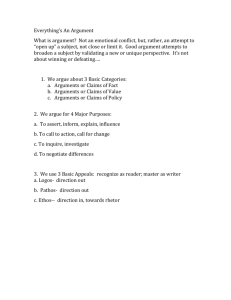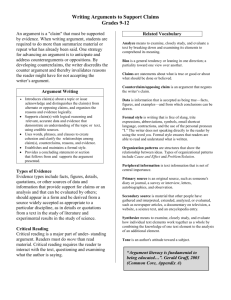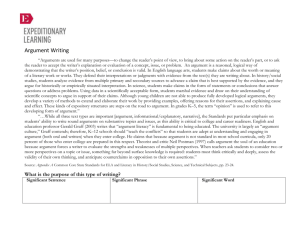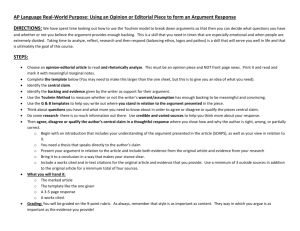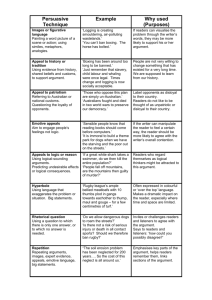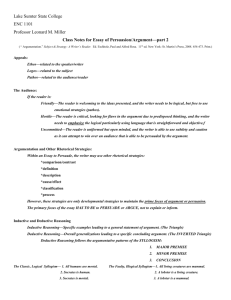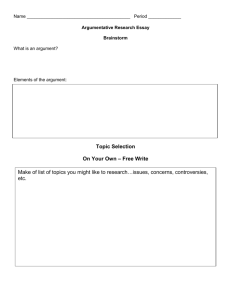ArgumentCard 6-8 PE - Transition to Common Core
advertisement
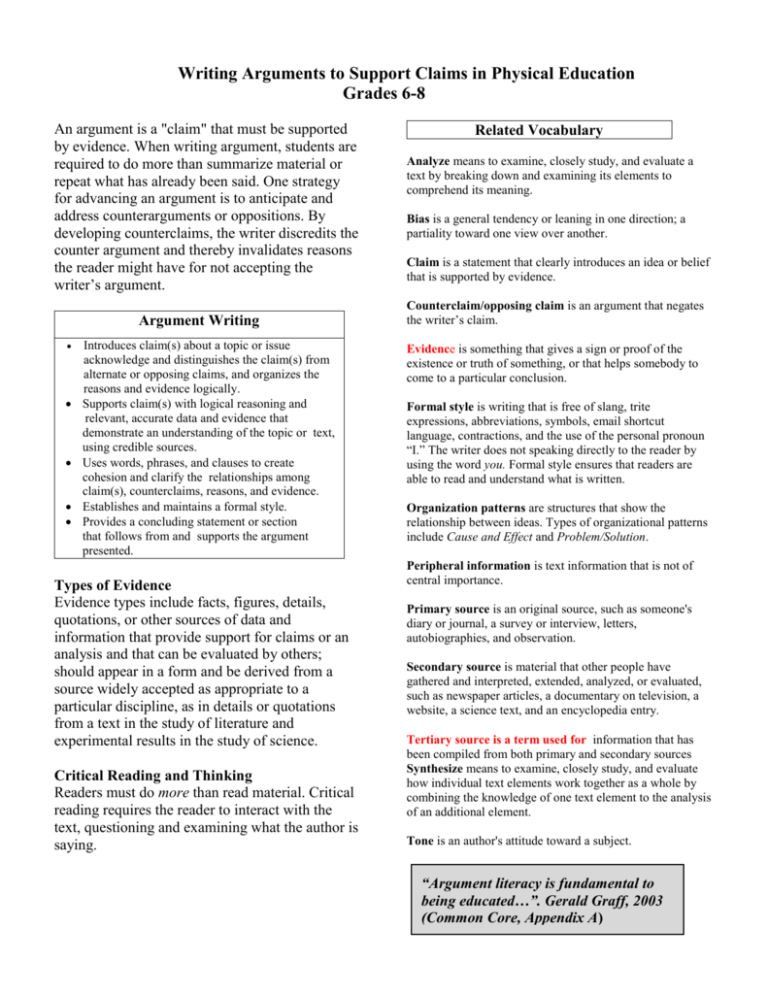
Writing Arguments to Support Claims in Physical Education Grades 6-8 An argument is a "claim" that must be supported by evidence. When writing argument, students are required to do more than summarize material or repeat what has already been said. One strategy for advancing an argument is to anticipate and address counterarguments or oppositions. By developing counterclaims, the writer discredits the counter argument and thereby invalidates reasons the reader might have for not accepting the writer’s argument. Argument Writing Introduces claim(s) about a topic or issue acknowledge and distinguishes the claim(s) from alternate or opposing claims, and organizes the reasons and evidence logically. Supports claim(s) with logical reasoning and relevant, accurate data and evidence that demonstrate an understanding of the topic or text, using credible sources. Uses words, phrases, and clauses to create cohesion and clarify the relationships among claim(s), counterclaims, reasons, and evidence. Establishes and maintains a formal style. Provides a concluding statement or section that follows from and supports the argument presented. Types of Evidence Evidence types include facts, figures, details, quotations, or other sources of data and information that provide support for claims or an analysis and that can be evaluated by others; should appear in a form and be derived from a source widely accepted as appropriate to a particular discipline, as in details or quotations from a text in the study of literature and experimental results in the study of science. Critical Reading and Thinking Readers must do more than read material. Critical reading requires the reader to interact with the text, questioning and examining what the author is saying. Related Vocabulary Analyze means to examine, closely study, and evaluate a text by breaking down and examining its elements to comprehend its meaning. Bias is a general tendency or leaning in one direction; a partiality toward one view over another. Claim is a statement that clearly introduces an idea or belief that is supported by evidence. Counterclaim/opposing claim is an argument that negates the writer’s claim. Evidence is something that gives a sign or proof of the existence or truth of something, or that helps somebody to come to a particular conclusion. Formal style is writing that is free of slang, trite expressions, abbreviations, symbols, email shortcut language, contractions, and the use of the personal pronoun “I.” The writer does not speaking directly to the reader by using the word you. Formal style ensures that readers are able to read and understand what is written. Organization patterns are structures that show the relationship between ideas. Types of organizational patterns include Cause and Effect and Problem/Solution. Peripheral information is text information that is not of central importance. Primary source is an original source, such as someone's diary or journal, a survey or interview, letters, autobiographies, and observation. Secondary source is material that other people have gathered and interpreted, extended, analyzed, or evaluated, such as newspaper articles, a documentary on television, a website, a science text, and an encyclopedia entry. Tertiary source is a term used for information that has been compiled from both primary and secondary sources Synthesize means to examine, closely study, and evaluate how individual text elements work together as a whole by combining the knowledge of one text element to the analysis of an additional element. Tone is an author's attitude toward a subject. “Argument literacy is fundamental to being educated…”. Gerald Graff, 2003 (Common Core, Appendix A) Writing Arguments to Support Claims in Physical Education Grades 6-8 Current fitness topics, events, and readings are excellent examples of relevant instruction that enables students to “write arguments focused on discipline specific content.” In the process of completing these assignments, students make sound claims based on evidence cited in documents. Connections with the National Examples: Standards for Physical Education: Essential Question: Is the FITT principle better achieved through time or intensity? 1. Demonstrates competency in motor skills and movement patterns needed to perform a variety of physical activities. Sample Student Claim: FITT is best achieved by a focus on time because as your time increases it would be natural to increase your intensity as well. *Students can justify why they chose to perform a specific movement over another, or explain their claim as to why they performed a movement in a certain tactical progression. Essential Question: How can proper throwing form, like the use of a lever, increase distance? Sample Student Claim: This increases the mechanical advantage of one’s arm or throwing implement giving the maximum amount of force to an object. 2. Demonstrates understanding of movement concepts, principles, strategies, and tactics as they apply to the learning and performance of physical activities. *Justifications of specific tactical concepts and strategies can be made by students as they connect them to performance tasks. 3. Participants regularly in physical activity. Essential Question: Explain how the accuracy of projectiles (balls, arrows) is dependent on factors such as speed of projectile, distance from target, weight of object, and number of body parts used. Sample Student Claim: There are several key components needed to assure an accurate shot with a projectile such as… Essential Question: Is it better to evaluate a peer’s complex motor task during a game situation or while performing the specific task. Support your claim. Sample Student Claim: It is better to evaluate a peer during a specific performance task so they will have multiple times to repeat the motor task. *Students can make claims supporting why physical activity is important for everyone, no matter what function of activity it maybe, not just athletes. 4. Achieves and maintains a health-enhancing level of physical fitness. *Students can justify supporting reasons for sustained physical fitness and the incorporation of healthy habits starting early on to promote a long and healthy life. 5. Exhibits responsible personal and social behavior that respects self and others in physical activity settings. *Arguments can be made that social skills and the need for cooperation learned in activity can be translated into real life situations and relationships. 6. Values physical activity for health, enjoyment, challenge, self-expression, and/or social interaction. *Students support claims that social and motor skills learned in class can transfer to real world experiences.


